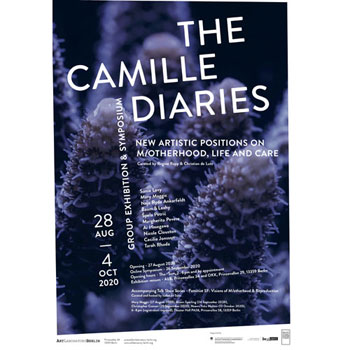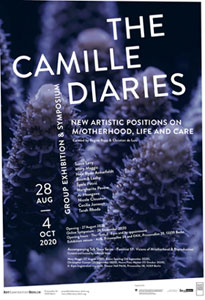AVIVA-Berlin >
Kunst + Kultur
AVIVA-BERLIN.de im Januar 2026 -
Beitrag vom 21.08.2020

Update: Konferenz-Programm jetzt online. THE CAMILLE DIARIES. New Artistic Positions on M/otherhood, Life and Care. vom 28. August ã 4. Oktober 2020 bei Art Laboratory Berlin. Gruppenausstellung | Symposium | Interviews
AVIVA-Redaktion
Installationen, Video, Objekte, Performance: Unter den gegenwûÊrtigen Bedingungen unserer Welt ã UmweltverûÊnderungen, Gender Aspekte, Biopolitik ã reflektieren elf internationale Kû¥nstlerinnen den Begriff "Mutterschaft" in einer stark geweiteten Form, nûÊmlich als ein ôÇSich-Kû¥mmern-umôÇ, als ein zwischenartliches Miteinander. Die begleitende Talkshow-Serie "Feminist SF: Visions of M/otherhood & Reproduction" bringt Forscher_innen aus Kunst, Literatur, Gender Studies und Synthetischer Biologie mit den Kû¥nstlerinnen in einen kritischen Dialog. Alle Infos zu den Themen, den Kû¥nstlerinnen auf AVIVA-Berlin.
Scroll down for English
GERMAN
AUSSTELLUNG & SYMPOSIUM
THE CAMILLE DIARIES.
New Artistic Positions on M/otherhood, Life and Care
Hier wird Welt als ein Leben verstanden, in der wir alle miteinander verstrickt sind (Menschen, Pflanzen, Tiere, Umwelt) ã auf molekularer, organischer, ethischer und biopolitischer Ebene. Die kû¥nstlerischen Positionen untersuchen Reproduktionsmechanismen, biochemische Verbindungen zwischen Menschen und Tieren, reflektieren kritisch die weiblichen Reproduktionsorgane und verweisen auf alternative Biomaterialien als "Source of life" in Zeiten der Rohstoffknappheit und Nahrungsmittelkrise.
Der Ausstellungstitel The Camille Diaries spielt auf die "Camille Stories" der Philosophin und Biologin Donna Haraway an ("Staying with the Trouble", 2016). Darin entwirft sie Science Fiction-Szenarien einer schwindenden BevûÑlkerung, welche Geburten durch Pflege zwischen den Arten ersetzt. Menschen pflegen das Erbgut vom Aussterben bedrohter Arten (wie jener MûÑnchsschmetterling), indem sie Teile jenes Genmaterials in ihrer eigenen DNA speichern.
Die Thematik biotechnischer Konfigurationen menschlicher KûÑrper, ein zentraler Moment in den Texten, stellt den Menschen an die Peripherie und lenkt vielmehr unsere volle Aufmerksamkeit auf andere Lebewesen. Dies schafft ã und das ist zentral fû¥r die geplante Veranstaltungsreihe ã ein GrundverstûÊndnis fû¥r andere Arten und Organismen unter feministischer Perspektive.
Sonia Levys 2-Kanal-Videoinstallation For the Love of Coralsist eine filmische Recherche û¥ber die alltûÊgliche Arbeit bei der Pflege gefûÊhrdeter Wesen, um sie vor ihrer bevorstehenden, vom Menschen verursachten AuslûÑschung zu retten. Mary Maggic untersucht in ihrer Arbeit Milik Bersama Rekombinan die surreale Landschaft eines stûÊdtischen indonesischen Flusses, der von Plastik kolonisiert ist und toxische Auswirkungen auf die Bewohner_innen der Umgebung hat. Naja Ankerfeldt und Baum & Leahy lassen sich fû¥r ihr Projekt Mammalga von den lebensrettenden FûÊhigkeiten von Algen inspirieren, und davon wie man sich mit Algen verbinden und als Algenfamilie Verwandtschaft schaffen kann. In der Installation Phytoteratology von é pela Petriá wurden Embryonen der Ackerschmalwand (Schotenkresse) in einem Bad mit Chemikalien aus dem KûÑrper der Kû¥nstlerin gezû¥chtet, was zu einer biochemischen ChimûÊre mit der Kû¥nstlerin als "Co-Mutter" fû¥hrte.
Margherita Peveres Wombs prûÊsentiert lebende Bakterienkolonien, die in wissenschaftlichen Glaswaren einen fleischûÊhnlichen Biofilm produzieren und in einer flû¥ssigen Umgebung wachsen, die mit den Hormonen der Kû¥nstlerin durchtrûÊnkt ist, sowie eine Fotoreihe. Ai Hasegawa reflektiert in ihrer Arbeit I Wanna Deliver a Dolphin... û¥ber einen artenû¥bergreifenden Akt der Mutterschaft. Nicole Cloustons Arbeit Mud (Berlin) stellt in 15 rechteckigen Acrylprismen Schlamm aus Berliner Seen und Flû¥ssen vor. Fû¥r die Arbeit HAEM hat Cecilia Jonsson einen Kompass aus Eisen geschaffen, das sie aus dem Blutprotein HûÊmoglobin gespendeter menschlicher Plazenten generiert hat. Tarah Rhodas Ourglass wiederum versteht sich als Hommage an die bemerkenswerte Allianz zwischen Pflanzen und Tieren durch Photosynthese und Atmung.
Das eintûÊgige Symposium am 26. September 2020 wird die Kû¥nstlerinnen zusammen mit Forscher_innen aus Geistes- und Naturwissenschaft in einen kritischen Dialog bringen. Auf der Grundlage der ausgestellten Werke werden Konzepte des "Collective survival" und "Arts of noticing" (A. Tsing) sowie "Staying with the Trouble" (D. Haraway) interdisziplinûÊr diskutiert.
Die gesamte Konferenz ist online unter: www.youtube.com
THE CAMILLE DIARIES. New Artistic Positions on M/otherhood, Life and Care wurde kuratiert von Regine Rapp & Christian de Lutz.
Die Termine und Veranstaltungsorte im ûberblick
A) Gruppenausstellung
Vernissage: Donnerstag 27. August 2020, 16 ã 21 Uhr (nach Anmeldung)
Orte: Art Laboratory Berlin, Prinzenallee 34, 13359 Berlin | OKK, Prinzenallee 29, 13359 Berlin
Laufzeit: 28. August ã 4. Oktober 2020, Do ã So, 14 ã 18 Uhr
Die Hygieneregeln werden bei Art Laboratory Berlin selbstverstûÊndlich eingehalten. Mehr Infos > www.artlaboratory-berlin.org
B) Symposium
Samstag, 26. September 2020, Online
Referent_innen: Kû¥nstlerinnen der Ausstellung sowie Geistes- und Naturwissenschaftler_innen
Das Konferenz-Programm ist online unter: www.artlaboratory-berlin.org
Begleitende Talkshow-Serie
Feminist SF: Visions of M/otherhood & Reproduction
Kuratiert und moderiert von Isabel de Sena
Mary Maggic (27. August 2020), Alison Sperling (24. September 2020), Christopher Coenen (29. September 2020), Noemi Yoko Molitor (13. Oktober 2020)
Ort: Theatersaal PA58, Prinzenallee 58, 13359 Berlin, 18 ã 20 Uhr (nur nach Anmeldung!)
Referent_innen aus Kunst, Literatur, Gender Studies und Synthetischer Biologie
Orte: Art Laboratory Berlin, Prinzenallee 34, 13359 Berlin | OKK, Prinzenallee 29, 13359 Berlin
ûffnungszeiten: Do ã So, 14 ã 18 Uhr
Die Hygieneregeln werden bei Art Laboratory Berlin selbstverstûÊndlich eingehalten. Mehr Infos > www.artlaboratory-berlin.org
Zur Registrierung am ErûÑffnungstag: docs.google.com
Mehr Informationen: www.artlaboratory-berlin.org und www.facebook.com/ArtLaboratoryBerlin
Assoziierte Projektpartner_innen:
Dieses Projekt entstand aus dem Open Call ôÇM/others and Future HumansôÇ als Teil eines kuratorischen Schwarmes, der von Ida Bencke (Labae, Copenhagen) und Eben Kirksey (Institute for Advanced Study, Princeton University) initiiert wurde.
Medienpartner_innen:
art-in-berlin.de, www.art-in-berlin.de
AVIVA Online Magazin fû¥r Frauen, www.aviva-berlin.de
ALB-Team: Regine Rapp, Christian de Lutz, TuûÏe Erel, Palooka Frank, Natacha Lamounier Ribeiro, Sarah Hermanutz, Ayla Warncke
Fotodokumentation: Tim Deussen, tim-deussen.de
Grafikdesign/ Poster: Eva-Maria Bolz, www.evamariabolz.de
Kooperationspartner_innen: OKK, Berlin, PA58, Berlin, Fachgebiet fû¥r Angewandte und Molekulare Mikrobiologie, TU Berlin
GefûÑrdert von: Hauptstadtkulturfonds | Berliner Senatsverwaltung fû¥r Kultur und Europa | Slowenisches Kulturinstitut Berlin

ENGLISH
EXHIBITION & SYMPOSIUM
THE CAMILLE DIARIES.
New Artistic Positions on M/otherhood, Life and Care
The exhibition and the symposium The Camille Diaries. New Artistic Positions on M/otherhood, Life and Care present new works by eleven international women and non-binary artists with installations, video, objects and performance. Reflecting on the current conditions of our world ã environmental changes, gender aspects, biopolitics, etc. ã the artistsôÇ positions propose an ôÇaesthetics of careôÇ as the basis for inter-species coexistence. Here the planet is understood as a symbiotic web in which we are all entangled with one another (humans, plants, animals, environment) on molecular, organic, ethical and biopolitical levels. The artists investigate reproductive mechanisms, biochemical connections between humans and nonhumans, and refer to alternative biomaterials as "source of life" in future times of scarcity and crisis.
The exhibition title The Camille Diaries alludes to the "Camille Stories", the final chapter of "Staying with the Trouble" (2016) by philosopher and biologist Donna Haraway, a speculative future where a dwindling human population replaces births with care between species. Each "Camille" cares for the genetic material of an endangered species (the monarch butterfly) by storing parts of that material in their own DNA.
In the exhibition artists explore genetic and biochemical exchange between human and nonhuman, as both part of and remedy for the Anthropocene. Here the theme of biotechnological trans-figurations of human bodies places the human being on the periphery and rather directs our full attention to other living beings. This creates ã and this is central to the planned series of events ã a basic understanding of other species and organisms from a feminist perspective.
Sonia LevyôÇs 2-channel video installation For the Love of Corals is a cinematic inquiry that focuses on the daily labour of caring for endangered beings to resuscitate them from their imminent human- induced extinction. Mary MaggicôÇs work Milik Bersama Rekombinan explores the surreal landscape of an urban Indonesian river colo-nized by plastic, with toxic implications for nearby inhabitants. For their project Mammalga Naja Ankarfeldt and Baum & Leahy find inspiration in the life remediating abilities of algae as well as ways of m /othering or making kin in algal family patterns. In é pela PetriáôÇs installation Phytoteratology thale cress embryos have been grown in a bath of chemicals from the artistôÇs own body, resulting in a bio-chemical chimera with the artist as ôÇco-motherôÇ.
Margherita PevereôÇs Wombs features scientific glassware hosting living bacterial colonies producing flesh-like biofilm, growing in a liquid environment infused with the artistôÇs own hormones. Ai Hasegawa proposes a transspecies act of motherhood in her work I Wanna Deliver a Dolphin... Nicole CloustonôÇs artwork Mud (Berlin) takes the form of 15 rectangular, polycarbonate prisms filled with organisms growing from mud taken from BerlinôÇs lakes and rivers. In HAEM artist Cecilia Jonsson and scientist Rodrigo Leite de Oliveira have created a compass by deriving iron from the blood protein haemoglobin of donated human placentas. Meanwhile Tarah RhodaôÇs Ourglass is a tribute to the remarkable alliance between plants and animals through photosynthesis and respiration.
The one-day symposium will bring the artists together with re-searchers from the humanities and natural sciences into a critical dialogue. On the basis of the exhibited works, concepts of "Collective survival" and "Arts of noticing" (A. Tsing) as well as "Staying with the Trouble" (D. Haraway) will be discussed in an interdisciplinary manner.
More information www.artlaboratory-berlin.org
Art Laboratory Berlin adheres to the rules of hygiene. More information: www.artlaboratory-berlin.org
Regine Rapp & Christian de Lutz (curators)
With the generous support of:
Hauptstadtkulturfonds | Berliner Senatsverwaltung fû¥r Kultur und Europa | Slowenisches Kulturinstitut Berlin
Associated project partners:
This project arose from the open call ôÇM/others and Future HumansôÇ as part of a curatorial swarm initiated by Ida Bencke (Labae, Copenhagen) and Eben Kirksey (Institute for Advanced Study, Princeton University).
Media partners:
art-in-berlin.de, www.art-in-berlin.de
AVIVA, Online Magazin fû¥r Frauen, www.aviva-berlin.de
Weiterlesen auf AVIVA-Berlin:
Interview mit Regine Rapp, Leiterin und Kuratorin von Art Laboratory Berlin anlûÊsslich der der Ausstellungs- und Veranstaltungsreihe Time & Technology (2012)
Shlomit Lehavi - Time Sifter bei Art Laboratory Berlin 23.03. - 29.04.2012 (incl. AVIVA-Interview mit der Kû¥nstlerin)
Copyright Fotos/Grafik: Eva-Maria Bolz unter Verwendung eines Fotos von Sonia Levy